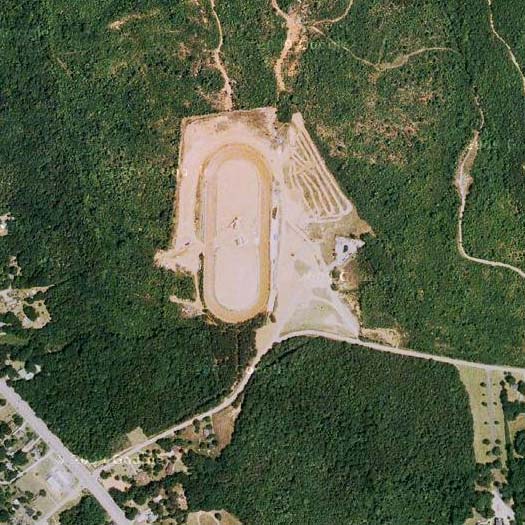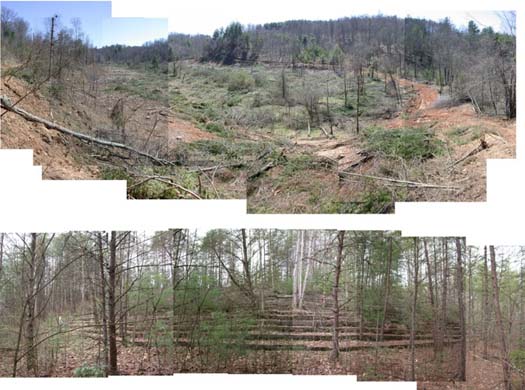
[Local speedway in Lancaster County, South Carolina; this is the speedway that sang me to sleep on Saturday nights for roughly twelve of the first fifteen years of my life]
In the comments on my post on soccer as a diagram traced on an exported landscape, Stephen notes that :
The landscape of [Formula One] racing is also an abstraction of urban space… [it] might be the only sport where temporary re-appropriation of an urban landscape by sport isn’t just an interesting OUA proposal, but commonplace. Where this field of play differs from those of soccer and American football, however, is in how the specificity of each landscape dictates very specific tactics for engaging it – basically, there are only one or two fastest lines around a racetrack. There is a fast space, surrounded by slow space… Because two cars can’t be in the same place at the same time, and unlike a field where there are many spaces with equal starting potential, timing your occupancy of the fast space becomes the critical tactical decision…
Which reminds Alexander Trevi of a CLUI exhibit on automotive test tracks, which he posted on a while ago, which in turn reminds me of this research project investigating the local speedways as social landscapes, by a landscape architect at Virginia Tech, Brian Katen:
“After my first race, I was intrigued by this other Virginia landscape that I had heard nothing about,” says Katen. “Virginia has well known places that present the commonwealth to visitors – Civil War battlefields, plantations, the Blue Ridge Parkway. “But there are other parts of Virginia that are important. Such as the crooked trail – a music trail from Ferrum to far Southwest Virginia, where bluegrass music comes from. And one-third of the local racetracks were in Southwest Virginia,” says Katen. “These are important places. The real power of racing – that ties the state together – emanates from Southwest Virginia. It is an important landscape that was unrecognized,” he says. “And it is an important social landscape that is not part of the Civil War battlefield and plantation way of understanding life in Virginia before television… “You are walking through the woods and you know the track is there somewhere. Then you realize that you are standing in it. The landform emerges out of the forest as your eye adjusts. Sometimes you feel yourself walking around a banked curve.”

As a Washington Post article on the project notes, Katen grew up around DC, but only became interested in the racetrack landscape after moving to southwestern Virginia to take a position at Virginia Tech. A chance meeting with a former driver at the Motor Mile Speedway near Blacksburg led to a passion for locating and documenting the vanishing racetracks:
He happened to sit down next to Turman’s family and got to talking with them. Turman, now 66, had raced in the 1960s, gaining a local following and running moonshine to fund his obsession. He had photos of races from that same track, one with his navy-and-white 1937 Ford shooting past a turn right into a pond. By the time he got the car out, Turman said, “I bet there was five or six ton of mud in it.” Like most drivers back then, he built his car from junkyard scraps. He raced different tracks every few nights. Thousands of fans would watch from hillsides or pastures.
Katen was fascinated. All those places had vanished. So he started looking for tracks using clues from newspaper ads, aerial photos and people’s memories. He drove back roads to find them, especially in the summers when he had more time to wander. He has found more than 120 tracks in Virginia — although by his count, only about 18 remain. He is building an archive of stories, photos of drivers and speedways, tickets and posters, filling in a part of the everyday history of Virginia that might otherwise be lost.
Some tracks closed because they didn’t make money, then were sold to developers or turned back into farmland. People became busy or lost interest, maybe staying home to watch NASCAR on TV instead. Some tracks are covered by lakes. One is underneath an Alexandria subdivision. Some are just ghosts, Katen said, a faint tracing in the grass where the dirt was compacted by all those spinning tires.

This slideshow of oval tracks put together by Katen is a fascinating tour of automotive landscapes, both defunct and active. Like the test tracks Trevi refers to, the oval tracks are easily read as encapsulating something fundamental about American culture’s love for cars, tires, engines, and roads, spatializing American culture in the land itself (as every culture always has), but they differ sharply from the test tracks in being primarily social, or even nostalgic, landscapes, places where “generations of families and old friends” gather to celebrate or remember having gathered.

